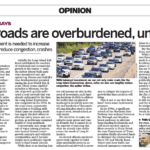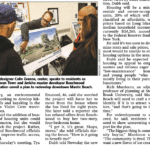The following was published on TheTruthAboutCars.com on 5/10/13.
I have two interests that are often in conflict with one another. One is my love of the automobile. The second is urban planning. Recently, I was reading a response piece to the notion that the car will become the next cigarette, or a similar “socially unacceptable vice”. Author Derek Kreindler wrote the following in his response:
But heavy-handed, top down solutions are not the answer. The next generation of urban planners are being educated in universities by liberal arts faculty members hold views that are largely not representative of the opinions and needs of the general public. Combine that with a growing apathy for the automobile among young people and you create a situation where anti-car sentiment is easily bred. Look no further than the move to ban EV charging stations from urban areas as a perfect example of their utter refusal to meet reality on reality’s terms.
I am 26, and am among the “next generation of urban planners” who was educated in those very universities the author cites. I majored in both political science and urban studies at Fordham University, and received my Masters in Public Policy from SUNY Stony Brook, where I focused on regional planning. My writing on land use issues has appeared in Newsday and other various online, print and television media outlets. Don’t judge because of my educational background and professional experience… I absolutely love cars. Here are my thoughts on the subject.
I am a lifelong resident of Long Island, New York. To most, Long Island is the boring space that lies between Manhattan and the Hamptons. I on the other hand see the 112 mile Island as so much more. Historically, Long Island was the birthplace of aerial innovation and set the template for suburban development across the United States. Our parkway system helped lay the groundwork for the Federal interstate system. Our unique environmental constraints helped create pioneering studies of population density (the measure of amount of people per square mile) and wastewater’s impact on groundwater. In fact, many of the land use preservation strategies employed on Long Island are replicated nationwide in an effort to help slow suburban sprawl.
As a planner, you constantly hear others promoting the dangers of suburban sprawl, continued dependence on the automobile, the need for “Smart Growth” and expansion of transit. These concepts are both valid and worthwhile. That does not make them the right approach for all areas. Like any other tool, these ideas are only useful when appropriate.
Unfortunately, there is rising trend in urban planning that is biased towards dense, urban environments. Ideas that once were legitimate planning concepts such as “smart growth” and “sustainable” development have become real estate industry buzzwords that no longer resonate with the informed public. Once again, these terms are legitimate development concepts, but their misapplication by the real estate industry have numbed their impact. These density-biased concepts, such as the notion of the automobile becoming stigmatized in a similar manner to the cigarette, ignore the realities of existing suburban land use patterns. Older suburban areas, such as Long Island’s own Nassau and Suffolk Counties, typify the concept of Euclidean Zoning, or segmented, separate land uses. Due to these segmented developments, the car is still very much a necessity for most Americans.
In recent years, there is the appropriate push to consolidate the tract housing developments, and blend commercial uses in with the residences. These “mixed-use” concepts look to revitalize struggling downtown areas that are in dire need of economic development. This is where the call for increased bicycle and transit usage comes in. As population density increases, these ideas slowly become viable. However, new-age urbanists have taken the notion too far, calling for measures that make it harder and harder to use a car to get around cities. These measures are the antithesis to driving enjoyment. Think about it though…is it ever pleasant to drive in a city, or would you rather navigate country backroads?
In a dense urban environment, measures to reduce automotive use are successful because of the population density. In suburban areas, these measures don’t work nearly as well. Ideas such as expansion of transit service is difficult to impossible to implement due to the lack of resident demand, federal subsidy and most importantly, population density to support more buses and trains. In fact, I’ve written a piececalling for further reinvestment in our road system on top of innovative suburban transit solutions. Another push has been for increased bicycle usage, which works well in the city. In suburban areas, the landscape and destinations are too spread out for widespread bike usage to be viable. Simply put, thanks to suburbia, the automobile is here to stay for a very long time.
These new age, idealistic concepts are almost always perceived by the general public as condescending, and reflect what I call ”ivory-tower” planning. All too often, the planners who suggest these ideas come off as smug, and seem to talk down to those who live outside of dense urban centers. This projected image, whether intentional or not, lessens the impact of their important message. Further, this ivory tower smugness leads to a generalized mistrust of urban planners by the public. I agree with my peers that the urban environment isn’t suited for the car. That being said, urban policy solutions, predicated on the notion of ample population density, are simply not appropriate for rural and suburban areas. Kreindler closed his piece with the following:
But still, don’t be surprised if this line of thought becomes part of the discourse at some point in the near future.
This line of thought is already entering public discussions in municipalities across the country, which isn’t a bad thing. Eventually, we will have to look beyond the automobile, and a planner’s job is to look ahead to anticipate future needs. What planners have to remember is that recommendations need to be grounded in reality and most importantly, be implementable. As I often say, there is no “one-size fits all” or silver bullet approach to solving this. While automobile reduction may work in Times Square, it isn’t suited for suburban areas across the country.
Readers, just remember: Not all planners hate the car. As a whole, we aren’t naive. We understand the car’s importance. Thanks to suburbia, the car will be popular for decades to come.











